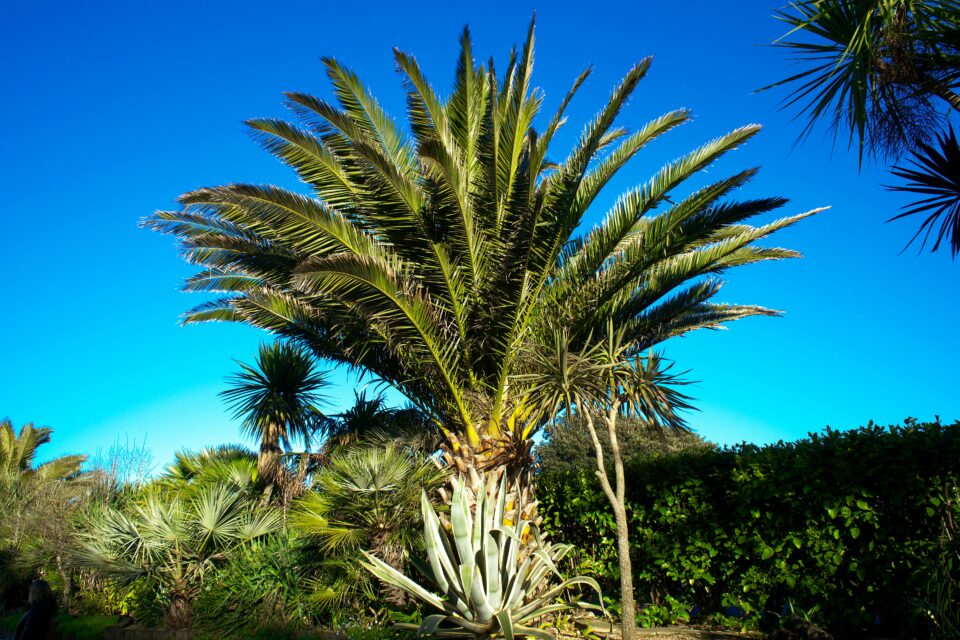Palm trees are synonymous with tropical regions and warm weather, bringing a sense of relaxation and exoticism to any landscape.
Palm trees are cherished for the tropical flair they add to any setting, but with so many palm tree types available, it can be hard to choose the right one for the landscape. When selecting palm trees for your garden consider function as well as environment.
palms are sun-loving tropical plants; some have surprising cold or shade tolerance, expanding their range of use. Some palm trees are well suited to planting as specimens or accents, while others perform better along the edges of the landscape.
Palm trees are the focal point of tropical gardens, and can even be used in more temperature zones to make a statement.
The Two Main Types of Palm Trees
There are many different types and species of palm trees; deciding whether to plant a dwarf or standard-sized palm in your backyard is the best place to start. Let’s look at the main differences between both of these:
- Dwarf Palm Tree: Dwarf palm trees can be used as statement trees in a small garden or as shrubs or hedges if you prefer the clustered look of the palm tree.
The average dwarf palm tree is less than 20 feet tall and can grow with a single large trunk or several trunks that are clustered together.
- Standard Palm Tree: A standard palm tree is typically any other palm tree that is over 20 feet tall. It may still have a single, large trunk or a number of smaller trunks grouped together.
On standard palms, the fronds or leaves, also get quite big. For instance, the classic coconut tree would be considered a standard palm tree.
12 Different Types Of Palm Plants
This is a selection process that involves organizing the different palm tree types into categories based on performance and visual characteristics.
1. Coconut Palm

The coconut tree whose botanical name is Cocos nucifera, unquestionably belongs to the palm tree family. Coconut palm trees, which date back to prehistoric times, are adored and highly appreciated today for their many products, including fibers and culinary purposes.
The tree typically stands between 60 and 80 feet tall, and its leaves can grow up to 15 feet long. A typical coconut palm won’t flower until its seventh year, but once it does, it will produce between 50 and 100 coconuts per year.
Unfortunately, you might not be able to grow a coconut tree in your typical backyard because they need a lot of humidity and sandy soil to thrive.
2. Spindle Palm
Spindle palm, whose botanical name is Hyophorbe verschaffeltii, is maturing at 20–25 feet tall. The spindle palm makes a wonderful specimen in smaller spaces, such as entryway planting beds and poolside gardens.
This stately palm has a somewhat formal look, with a smooth trunk ringed with leaf scars and a loose, open canopy of 10-foot-long arching foliage.
3. Canary Island Date Palm

Canary Island date palm is the poster child of tropical gardens. This majestic tree has a huge canopy of deep green, arching fronds set atop a stout trunk crisscrossed with diamond-shaped leaf scars.
With a mature height of 40–60 feet and a spread up to 40 feet at maturity, Canary Island date palm makes a statement in larger landscapes. Hardy in zones 9–11, this palm can be planted as a single specimen or in groups along a border. In cooler regions, it can be grown in containers.
4. Queen Palm
Queen palm, whose botanical name is Syagrus romanzoffiana, is generally inexpensive and a great selection for those trying to create a finished look on a low budget.
Growing to a height of 40 feet, the single-trunk palms can be planted in groups to quickly create shade. This palm is very popular; however, it does have one main drawback: it produces an abundance of fruit, which can cause quite a mess.
5. Bottle Palm
Bottle Palm, whose botanical name is Hyophorbe lagenicaulis, makes an eye-catching accent in any garden.
Slowly growing to a mature height of 10 feet, though more typically between 5 and 7 feet tall and wide, the bottle palm is cold-sensitive and only hardy in zones 10–11.
The open canopy boasts long, stiff fronds, adding to the plant’s interesting architecture. This palm is easy to care for with few problems.
6. Bismark Palm
Bismark palm whose botanical name is Bismarckia nobilis. Some of the most spectacular palms are those with blue-tinged foliage. With a rounded crown of stiffly upright, steel-blue fronds, the Bismarck palm is striking in both color and form.
Each fan-shaped frond is 4 to 5 feet long and wide, providing plenty of textural contrast to the garden. Provide plenty of space around this beauty to show off its remarkable features.
7. European Fan Palm
European fan palm, whose botanical name is Chamaerops humilis and is also called Mediterranean fan palm, stands out in the landscape for its dense covering of fine-textured, bright green fronds.
The only palm native to Europe, this species is quite hardy, performing well in zones 8 through 11 (and even as low as 7b with protection). This slow-growing, clump-forming palm matures at 8 to 15 feet tall and 6 to 10 feet wide.
8. Mexican Fan Palm
Mexican fan palm, whose botanical name is Washingtonia robusta, stands up well to wind, salt, and humidity, making it widely adaptable. Considering its origins, one is not surprised that Mexican fan palm is heat- and drought-tolerant.
Mexican fan palm has naturalized in parts of Florida, California, and Texas, where it performs well in hardiness zones 9–11. This fast-growing palm can reach heights of 30–50 feet in 10 years while keeping a narrow profile of just 6–10 feet.
9. Windmill Palm
Windmill palm, whose botanical name is Trachycarpus fortune, is a stout palm with fan-shaped fronds and a compact habit. Though mature plants can reach 25 feet tall and 6–10 feet wide, windmill palms grow slowly and will remain small for many years.
Windmill palm is well suited to smaller landscapes. They perform best in partial shade and are moderately drought-tolerant once established. They are the most cold-hardy of the tall palms, tolerating temperatures down to 10˚F, extending their range of use far to the north.
10. Saw Palmetto
Saw palmetto, whose botanical name is Serenoa repens, is another native species. The saw palmetto grows naturally throughout Florida and along both coasts, east to Louisiana and north to South Carolina.
This slow growing, clumping palm grows 5 to 10 feet tall and spreads 4 to 10 feet wide. Plants are highly salt-tolerant, making them an excellent selection for coastal gardens.
Saw palmettos are very adaptable to a range of growing conditions, tolerating wet or dry soils, shady and sunny sites, and acid-to-alkaline soils. Several selections are available with silvery-blue foliage, including the cultivars ‘Sericea’, ‘Cinerea’, and ‘Glauca’.
11. True Date Palm
True date palm, whose botanical name is Phoenix dactylifera, is an ancient and well-known palm tree that is native to the Middle East, Africa and some parts of Asia. The date palm, which is prized for its delectable dates, grows abundantly in tropical climates and is still a valuable resource and food source today.
The stunning, classic palm can reach a height of approximately 23 meters (75 feet). Its stem, which is prominently defined by the clipped stubs of old leaf bases, ends in a crown of beautiful, glossy, pinnate leaves that is about 16 feet (5 meters) long.
It can thrive in any type of soil, even poor and rocky soil. It’s also quite drought-resistant once established, and can withstand temperatures of up to 122 degrees Fahrenheit.
12. Pindo Palm
Pindo palm, whose botanical name is Butia capitata, is native to Brazil but thrives as an ornamental tree in the Mediterranean and Southern United States, is known for its robust trunk and feathery fronds. These trees can occasionally reach 100 feet in height, but this is uncommon because they are slow-growing and thrive in high humidity.
This beautiful palm tree is also known as the ‘Jelly Palm’ in some areas since it’s an indigenous plant that produces edible berries that can be converted into jelly with a sweet banana/pineapple flavor. The fruits are about an inch in diameter and have a seed in the center.
This palm has a distinctive look that is also practical. It is frequently used for smaller lawns and looks great as a focal point. The average height of this palm tree is around 15 to 20 feet.
Benefits Of Palm Plants
When we think of palm trees, we think of beaches and tropical paradises. This immediately makes us feel better and more at ease.
Palm trees are associated with wonderful, warm climates, blue waters, white beaches, and relaxation. Though this is often true, there are many other benefits to palm trees that you might not be aware of. You’d be surprised at some palm tree benefits and might even consider them for your home faster.
- Oxygen Level: Palm trees are excellent sources of oxygen, even in relative terms to other plants. They produce a fantastic amount of oxygen, which helps pretty much everything in your body. Having regular access to high-oxygen air can result in general improvements in metabolic functions and have a wonderful impact on your respiratory system.
- Air purifying: Not only do palm trees have a wonderful contribution to the oxygen levels in your home, but they also have air-purifying qualities. These plants are able to catch particles in the air that can potentially be harmful to humans. What a wonderful ally palm trees are when you keep them indoors!
Palm trees are pretty decent at collecting dust as well, though there are plants that are better. They are able to catch dust particles that you don’t want in your body and store them on their leaves.
- Allergies: Palm trees are fantastic plants to have in your house if you have allergies. Not only do they help to clean the air of things that can trigger general allergies, but they are also known to lower pollen counts as well. This means you might experience less of a flare-up of certain allergies by having a couple of these around.
- Reduces Stress: Plants help to reduce stress in humans. It has been found that people who are surrounded by plants regularly tend to report feeling less stressed than people who are not. This might have something to do with our oxygen levels or our innate desire to be around nature.
This is technically the case for all plants, though palm trees have the added tropical, warm association, as well as even appearing laid back. Having one of these beauties in your home office will help to settle the mind and body.
Conclusion
In conclusion, palms are used by humans for food, shelter, medicine and crafts. Palms are also among the most common tree species in the Amazon rainforest. But in some tropical areas, they are conspicuously absent.



